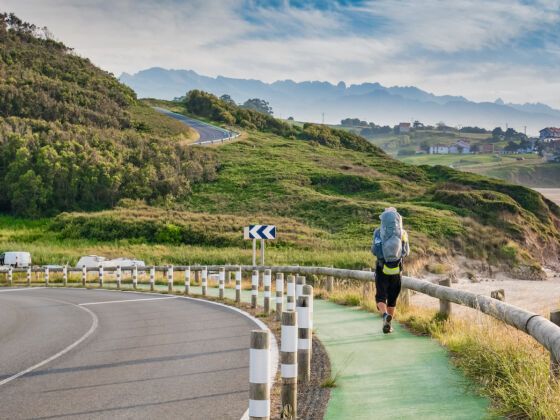It was morning in Villamayor de Monjardín, Spain. I woke, laced my boots, hoisted my backpack onto my back and stepped back out onto the Camino Francés, a pilgrim trail that goes between St. Jean Pied-de-Port and Santiago de Compostela. A spring thunderstorm the night before had dampened the dirt path. I looked at the lush, spring-speckled Spanish landscape around me and ahead to the trail that wound its way to Santiago de Compostela six-hundred-and-something kilometers away. Pilgrims in bright jackets walked in front of me under silver-gray storm clouds. I suspected we were all on our way to our first café con leche of the day. It was a wakeup-walk-eat-sleep day like any other on the Camino.


Walking the Camino de Santiago: What One Man Taught Me
I had asked myself for miles since I began in Pamplona what the hell had made me decide to walk to Santiago. Now, I wondered about the other pilgrims. Who were these people and why were they here? I hadn’t really been thinking about those questions until I met Oliver, an energetic older man I met on the path to Villamayor de Monjardín the day before. He caught my attention because of his South African accent and a weather-beaten, one-eyed teddy bear, Rudyard, in his backpack.
Oliver was originally from South Africa and now lived in the UK — it was our common hometown of Cape Town that had initially sparked conversation. He had owned Rudyard as a baby and had passed him onto each one of his three children when they were born. “He’s been teethed on and sucked,” Oliver explained. Rudyard had recently been rediscovered in some old boxes and Oliver now transported him along the Camino. He included him in conversations and often asked, “Rudyard, what do you think?” Rudyard would remain silent and Oliver would invent an opinion for him.
“Let me guess — you’re from the Southern suburbs,” he said.
“Actually, I live in Camps Bay,” I replied.
“Camps Bay? That’s where I grew up!” He launched into stories about his childhood adventures on Camps Bay beach. As I listened, the pain in my feet faded — and so did the miles. My favorite story of Oliver’s was about the corrugated iron boat.
“I worked for weeks, I even had slats for benches. But as an eleven-year-old, I had no notion that putting the seat where I did would raise the centre of gravity, capsize said boat and cast us into the bottom of the Atlantic. It’s probably still at the bottom of the ocean in Camps Bay.”
Later that night there was a knock on the door of our female dorm in the albergue. I opened it to find Oliver. “Please, I can’t take another night of snoring,” he said. “There’s a rather large man napping and he’s already trumpeting. Do you ladies mind?”
We welcomed him in.
Oliver began to unpack on the bottom bunk of the bed next to mine. He was a far more somber man now than the one who had regaled me on the Camino. He barely looked at me. Finally, he said, “Reminiscing about Cape Town brings up some uncomfortable memories for me.”
Oliver stopped talking and thumbed at Rudyard’s only eye. I waited. “My son was murdered,” he said.
My heart froze. “I’m so sorry,” I said. The word echoed in my head. Murdered.
“It’s okay,” he said. “It was a long time ago.” I wanted to ask him what happened but didn’t want to intrude into his memories or his pain.
He asked, “Have you heard of the Saint James Church Massacre?”
Most Capetonians know of this tragic, politically-charged event that took place in 1993 in Kenilworth, Cape Town. I had even written an essay on it in school.
“He went with two girls to church that evening. When the men stormed the congregation with AK-47s he pulled them down, but one got up again. When he stood up to get her back down, he was shot in the head. He was seventeen.”
“The Way of Saint James…” I said.
“That was the whole point of my first Camino years ago,” Oliver said. “But listen to this…The attack happened on the 25th of July, which is Saint James day in Spain. And in Spain, when Saint James day is on a Sunday, the year is considered the Holy Year of Saint James. And the 25th fell on a Sunday in 1993. That’s weird, don’t you think?”
He continued, “I planted seventeen crosses along the Camino, one for each year of Richard’s life. I offered prayers for the names of people inscribed on each cross. Some names were of friends who were seriously ill and others for the families of people who had died. They are still out there somewhere. I walked until Finisterre. My wife and daughters met me there and we threw his cross into the ocean in an act of catharsis.”
Beginning again the next day, I brought my awareness back to the dirt path I would continue to walk for days on end. Oliver’s story had made me wonder about all the pilgrims around me and everyone I had distractedly greeted with “Buen Camino.” I had formed a habit of making assumptions about the competitive, Quechua-clad athletes who gunned for the finish line but Oliver’s story left me with little doubt that everyone had a reason for undertaking the Camino.
I stared across the dew-speckled landscape and felt a sudden wave of compassion for all my fellow pilgrims and a longing to know their life stories.
“The Camino is supposed to imitate life,” a friend with Camino experience had told me before I left Cape Town. My Camino, and the Caminos of all the other pilgrims I walked with, had begun well before we reached Saint Jean Pied-de-Port and would continue long after we made it Santiago.